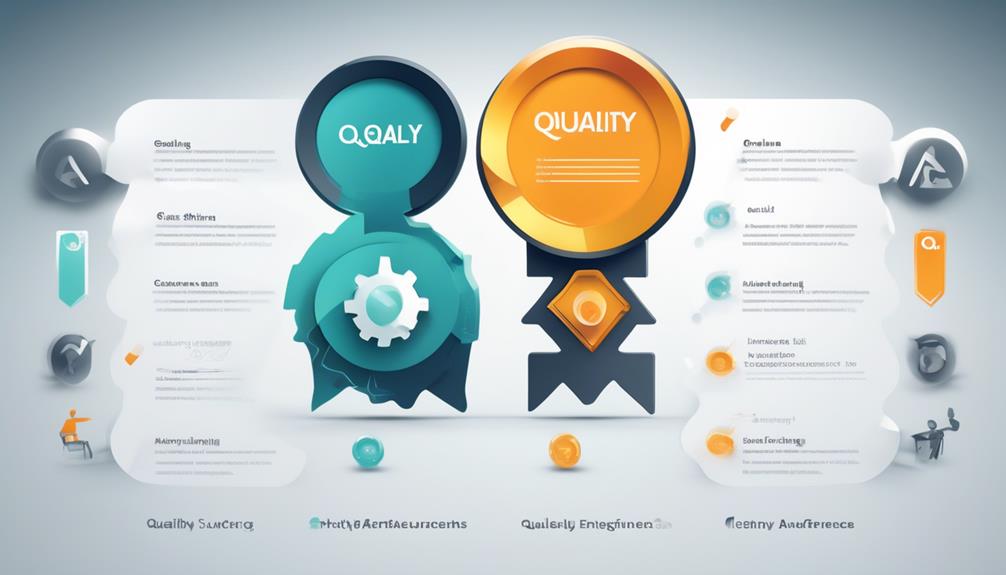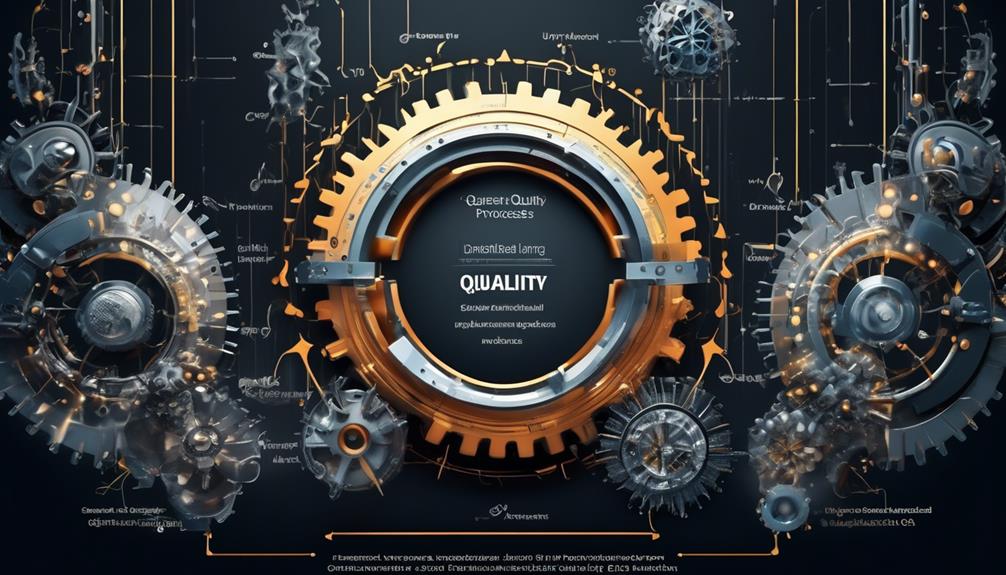When delving into the complex realm of software development, understanding the subtle differences between Quality Assurance (QA) and Quality Engineering (QE) is crucial. This comparison is akin to distinguishing between fixing a leaky faucet and overseeing the entire plumbing system.
The distinction between QA and QE is not just a matter of semantics; it’s about a fundamental shift in mindset and methodology that can significantly impact the success and quality of a product.
| Aspect | Quality Assurance (QA) | Quality Engineering (QE) |
|---|---|---|
| Definition | A systematic approach to monitor and improve the development process to ensure the product meets predetermined standards. | An advanced approach that integrates quality practices throughout the entire development lifecycle. |
| Focus | Monitoring and improving processes to ensure final product quality. | Implementing rigorous processes and best practices at each development stage to prevent defects. |
| Approach | Reactive; focuses on defect detection through various testing methods. | Proactive; focuses on defect prevention and incorporates quality into every aspect of software development. |
| Methodology Alignment | Often operates within specific development methodologies like Agile or Waterfall. | Aligns well with Agile and DevOps, emphasizing continuous integration and delivery. |
| Scope | In addition to QA tools, it emphasizes advanced analytics, machine learning, and automation to optimize testing and development processes. | Typically, it involves defining quality standards, creating testing plans, and conducting testing. |
| Tools and Techniques | Utilizes automated testing software, version control systems, and bug tracking systems. | Monitor and improve processes to ensure final product quality. |
| Skills and Certifications | Requires a deeper understanding of software architecture and data analysis; certifications like ASQ’s Certified Quality Engineer (CQE) are relevant. | It extends to optimizing the development process itself, collaborating across teams, automating processes, and using data analysis. |
| Goals | Ensures consistent quality, minimizes risks, increases efficiency, and delivers a reliable product. | Aims for fewer defects, faster development velocity, reduced costs, and overall enhanced product quality. |
By peeling back the layers of these two disciplines, we uncover a world of insight into how each contributes to the overall goal of delivering exceptional software.
Key Takeaways
- QA focuses on preventing defects, while QE focuses on building quality into the product.
- QA ensures compliance with standards and processes, while QE is responsible for designing and implementing automation frameworks.
- QA performs manual testing and conducts functional testing, while QE performs automated testing and conducts performance and security testing.
- Both QA and QE contribute to the overall quality of the software, but QE leads to fewer defects, faster velocity, and reduced costs, while QA may cause delays.
Defining Quality Engineering and Quality Assurance

In quality engineering and quality assurance, the distinction lies in their focus on incorporating quality throughout the product lifecycle and improving quality through testing, respectively.
Quality engineering (QE) prioritizes customer needs and user experience throughout the development cycle. It aims to prevent defects through rigorous processes and best practices, ensuring overall product quality at every phase of development. Techniques such as shift left and shift right are employed to achieve this.
On the other hand, quality assurance (QA) aims to ensure consistency and adherence to quality standards through various testing types throughout the lifecycle, focusing on the detection of defects rather than prevention. It specifically focuses on remediating defects to enhance the quality of the software product.
While QE focuses on the proactive incorporation of quality, QA focuses on reactive measures to improve quality. Understanding these distinctions is crucial for implementing effective quality measures in software development, as both QE and QA play indispensable roles in achieving high-quality software products.
Role in Software Development

Transitioning from the discussion on the distinction between quality engineering and quality assurance, the role of these processes in software development is pivotal to ensuring high-quality products. In the software development process, both quality engineering and quality assurance play a crucial role in maintaining the integrity and functionality of the product. Here are some key points to consider:
- Integration into Product Development Lifecycle: Quality engineering integrates quality practices throughout the entire product development lifecycle, ensuring that quality is a continuous focus from ideation to deployment.
- Agile and Continuous Improvement: Both quality engineering and quality assurance are essential in Agile environments, promoting continuous improvement and adaptation throughout the development process.
- Testing Subject Matter Expertise: Quality assurance teams typically specialize in testing subject matter expertise, conducting various tests such as automation testing, security tests, and machine learning-driven testing.
- Defect Prevention and Remediation: While quality engineering focuses on defect prevention, quality assurance plays a significant role in defect remediation, ensuring that the software meets the desired quality standards.
These factors collectively contribute to the overall quality of the software, ensuring that it meets customer needs, functions effectively, and aligns with industry standards.
Key Differences and Distinctions

Examining the key differences and distinctions between quality engineering (QE) and quality assurance (QA) reveals significant insights into their respective scopes, approaches, integration, methods, and impact within the software development process. QE encompasses the entire product lifecycle, aiming to prevent defects and prioritize customer needs and user experience, whereas QA focuses on defect detection during the testing phase. The table below highlights the key disparities between QE and QA:
| Aspect | Quality Engineering (QE) | Quality Assurance (QA) |
|---|---|---|
| Scope | Incorporates quality throughout the product lifecycle | Focuses on defect detection during testing phase |
| Approach | Prioritizes customer needs and user experience | Aims to improve quality through testing and defect remediation |
| Integration | Utilizes shift left and shift right techniques | Integral part of quality engineering, relies on dedicated testing team |
| Methods | Aligns with Agile and DevOps processes | Plays a role in achieving stable, usable software through various testing types |
| Impact | Leads to fewer defects, faster velocity, and reduced costs | May require redesigning the product, causing delays and resource requirements |
These differences are crucial in understanding the distinct roles and impacts of QE and QA within software development, emphasizing the importance of integrating both for enhanced software quality, user satisfaction, and efficient development processes.
Driving Trends Towards QE Over QA

Driving trends towards QE over QA are increasingly shaping the landscape of software development by emphasizing a holistic approach to quality that spans the entire product lifecycle. In this shift from QA to QE, the focus is on creating a continuous feedback loop to anticipate and act on issues throughout the development process. This approach involves a proactive mindset that integrates engineering and quality assurance, with the goal of preventing defects rather than solely identifying them.
- Quality Engineering vs. Quality Assurance: The distinction lies in the proactive nature of quality engineering, which focuses on building quality into the development process rather than solely verifying the end product.
- Development QE: Quality engineering is integrated into the development process, ensuring that quality is a core consideration at every stage.
- Continuous Feedback Loop: QE emphasizes a continuous feedback loop to anticipate and act on issues, fostering a proactive approach to quality.
- Quality Engineers: The role of quality engineers is pivotal in QE, as they’re involved in the entire development lifecycle, working to embed quality into every aspect of the process.
This shift from QA to QE reflects a fundamental change in mindset, moving from reactive quality assurance to proactive quality engineering, ultimately driving trends towards QE over QA.
Methodologies and Tools for QA and QE

Focusing on the methodologies and tools for QA and QE allows us to delve into the specific processes and resources that support quality assurance and quality engineering throughout the software development lifecycle.
Quality Engineering (QE) emphasizes incorporating quality throughout the product lifecycle, prioritizing customer needs, and promoting transparency and traceability. Techniques such as shift left and shift right, test-driven development, and canary testing are employed in QE to ensure high quality. QE aligns well with Agile and DevOps processes, ensuring quality throughout the CI/CD pipeline.
Transitioning from Quality Assurance (QA) to QE involves creating new roles and recognizing quality as everyone’s responsibility. QE leads to fewer defects, faster velocity, and reduced costs, preventing issues in areas such as performance, stress, load, security, and network bandwidth.
In terms of tools, both QA and QE utilize a combination of automated and manual testing tools to ensure the quality of the software. Additionally, they leverage tools and methodologies to enhance user experience, such as usability testing, feedback collection, and continuous improvement practices.
These methodologies and tools play a critical role in ensuring that quality is ingrained in every aspect of the software development process, ultimately leading to a superior end product.
Frequently Asked Questions
Is QA and QE the Same Thing?
No, QA and QE aren’t the same thing.
Quality Assurance focuses on testing and defect detection, while Quality Engineering incorporates quality practices throughout the product lifecycle, prioritizing prevention and customer needs.
QE employs techniques like shift left and shift right, leading to fewer defects, faster velocity, and reduced costs.
Transitioning from QA to QE requires creating new roles and recognizing quality as everyone’s responsibility, ensuring overall product quality at every phase of development.
What Is the Difference Between QA Lead and QE Lead?
As QE leads, we focus on integrating quality throughout the product lifecycle, emphasizing prevention over detection, and involving all development teams in ensuring quality.
In contrast, QA leads typically focus on testing and defect detection rather than prevention, relying on a dedicated team.
QE leads prioritize customer needs, transparency, and techniques like shift left and shift right, while QA leads focus on various testing types and defect remediation.
What Is the Shift From QA to Qe?
Transitioning from QA to QE involves a shift towards a more proactive and quality-centric approach. It focuses on preventing defects rather than just detecting them.
This move requires a deeper understanding of the product and its users, as well as a stronger emphasis on collaboration and continuous improvement.
It’s akin to moving from being a firefighter to a fire prevention specialist, where our efforts are geared towards avoiding issues before they occur.
How to Convert From QA to Qe?
To convert from QA to QE, we need to focus on transitioning from a quality assurance mindset to a quality engineering mindset. This involves shifting from a reactive approach to a proactive one, emphasizing prevention over detection.
We should integrate quality into every stage of the software development lifecycle, leveraging automation and continuous testing.
Conclusion
In conclusion, the shift from QA to QE is crucial for modern software development. By prioritizing customer needs and incorporating quality throughout the product lifecycle, QE leads to fewer defects, faster velocity, and reduced costs.
Embracing QE as everyone’s responsibility is the key to success in today’s competitive market. So, let’s embrace QE and leave the old QA approach in the dust.









